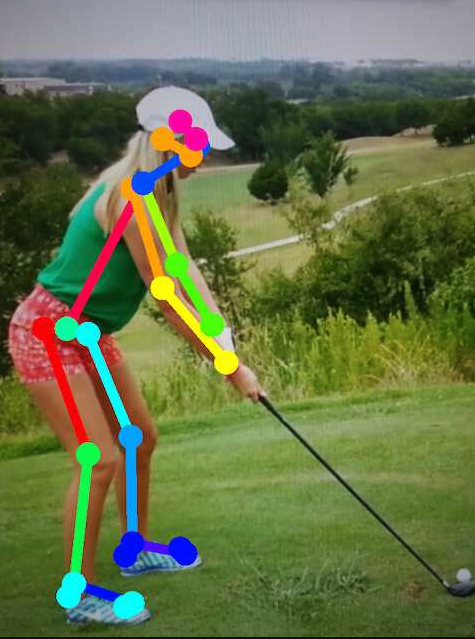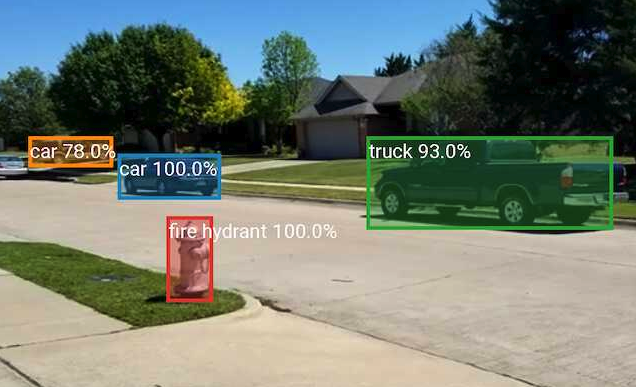Use the Computer Vision Server REST API
Last Modified: 11/24/21
This document describes how to use the REST API for the EdgeXR Computer Vision Server. In general, all requests require an image parameter, that includes the image to be processed. This image can be in either PNG or JPEG format.
The server supports several different Content-Type values in the HTTP request. For each Content-Type, there are different rules for how the image data must be included.
Note: In all cases, using JPEG is encouraged because of its smaller image size which results in faster overall processing.
Content-Type | Image Data |
|---|---|
image/png | The request body is made up of raw image bytes in the PNG format |
image/jpg | The request body is made up of raw image bytes in the JPEG format |
multipart/form-data | Raw image bytes are included as part of a multi-part form with an input type of file and a name of image, and that part's |
application/x-www-form-urlencoded | The image is Base64-encoded and included as a POST parameter named image |
In the curl examples included below, the multipart/form-data format is used. Different HTTP libraries in different languages may use one of the other Content-Type formats, so we have added support for the most common ones.
Please note that the hostnames used in the examples are only examples. Normally, your app would perform a FindCloudlet call, and use the FQDN from the result. See the SDK Documentation for details. Alternatively, you can find a dynamic list of sample hostnames you can use here.
Face Detection
/detector/detect/
Used to send a face image to the server and get back a set of coordinates for any detected faces.
POST
https://<hostname>:8008/detector/detect/
Parameters
Parameter | Description |
|---|---|
image | The face(s) image |
Return
JSON string with the following attributes.
Attribute | Description |
|---|---|
success | "True" if face detected, otherwise "false" |
serverprocessingtime | The time in milliseconds that it took the server to process this image |
rects | A JSON array of coordinates containing the detected faces. Rectangle format is left, top, right, bottom, in relation to the upper-left origin of 0, 0. Only included if "success"="true" |
Examples
Single face detected:
curl https://reservable6.berlin-main-tdg.eu.app.tdg.edgexr.org:8008/detector/detect/ -F "[email protected]"
{"success": "true", "serverprocessingtime": "19.873", "rects": [[73, 76, 147, 150]]}Multiple faces detected:
curl https://reservable6.berlin-main-tdg.eu.app.tdg.edgexr.org:8008/detector/detect/ -F "image=@face_triple.jpg"
{"success": "true", "serverprocessingtime": "30.898", "rects": [[6, 104, 59, 157], [68, 165, 138, 235], [120, 28, 189, 97]]}No faces detected:
curl https://reservable6.berlin-main-tdg.eu.app.tdg.edgexr.org:8008/detector/detect/ -F "image=@single_pixel.png"
{"success": "false", "serverprocessingtime": "0.030"}Face Recognition
/recognizer/predict/
Used to send a face image to the server and get back a set of coordinates for the recognized face, along with a subject name value if the face is recognized against the current trained data.
Note: This call is limited to a single face. At training time, no images are added to the set if more than one face is detected. If more than one face is present in an image for this call, prediction will only be performed on the first face detected.
POST
https://<hostname>:8008/recognizer/predict/
Parameters
Parameter | Description |
|---|---|
image | The face image |
Return
JSON string with a success value of true or false, and if successful, the following JSON values are provided:
Attribute | Description |
|---|---|
success | "True" if face recognized, otherwise "false" |
subject | Name of detected face |
confidence | Level of confidence. Actually a measure of distance the features are from matching a given subject. Lower is better, with 0 being a perfect match |
rect | Coordinates of detected face |
serverprocessingtime | Time in milliseconds that it took the server to process this image |
Note: This call will return subject names even with very poor (high distance) confidence values. It is up to the caller to decide what it considers a good prediction. For instance in the EdgeXR SDK Demo app, the RECOGNITION_CONFIDENCE_THRESHOLD value is 105, which means that any image with a confidence value higher than that will be shown with a subject name of Unknown.
Examples
Face detected and recognized:
curl https://reservable6.berlin-main-tdg.eu.app.tdg.edgexr.org:8008/detector/detect/ -F "[email protected]
{"success": "true", "subject": "Bruce Armstrong", "confidence": "71.850", "serverprocessingtime": "48.218, "rect": [73, 78, 146, 151]}Face not detected:
curl https://reservable6.berlin-main-tdg.eu.app.tdg.edgexr.org:8008/detector/detect/ -F "image=@single_pixel.png"{"success": "false", "serverprocessingtime": "0.082"}Training data update in progress:
curl https://reservable6.berlin-main-tdg.eu.app.tdg.edgexr.org:8008/detector/detect/ -F "[email protected]"<HTTP/1.1 503 Service Unavailable>
{"success": "false", "error": "Training data update in progress"If this state is encountered, it should only last a few seconds.
Pose Detection
/openpose/detect
Used to send an image with one or more human bodies to the server and get back a set of coordinates for any detected poses, where a pose is a list of bones for a given human body in the image. In our implementation, pose detection requires a GPU in order to run. If the server executing this call does not have GPU support, a 501 Not Implemented response will be returned along with the message "OpenPose not supported on this server".
POST
https://<hostname>:8008/openpose/detect/
Parameters
Parameter | Description |
|---|---|
image | The body/bodies image |
Return
JSON string with the following attributes.
Attribute | Description |
|---|---|
success | "True" if pose detected, otherwise "false" |
serverprocessingtime | The time in milliseconds that it took the server to process this image |
poses | A JSON array of coordinates containing the detected poses. Only included if "success"="true" |
Examples
No GPU Support:
curl -v https://reservable6.berlin-main-tdg.eu.app.tdg.edgexr.org:8008/openpose/detect/ -F "image=@6_bodies.jpg"
<HTTP/1.1 501 Not Implemented>
OpenPose not supported on this serverSingle body detected:
curl https://cv-gpu-cluster.berlin-main-tdg.eu.app.tdg.edgexr.org:8008/openpose/detect/ -F "[email protected]"
{"success": "true", "serverprocessingtime": "35.358", "poses": [[[81.44993591308594,
60.397254943847656, 0.8385379910469055], [62.35408401489258, 71.56185150146484, 0.7587199807167053], [57.761253356933594, 72.89726257324219, 0.7079280018806458], [70.91712951660156, 109.7353744506836, 0.8329359889030457], [91.94576263427734, 132.76388549804688, 0.7801129817962646], [66.98677062988281, 70.2525863647461, 0.6113029718399048], [76.14794158935547, 98.54723358154297, 0.7279360294342041], [88.695068359375, 126.8495864868164, 0.5476869940757751], [37.99922561645508, 119.61351776123047, 0.6892729997634888], [29.478424072265625, 118.96443939208984, 0.6695190072059631], [45.24222183227539, 161.7540740966797, 0.8158119916915894], [39.353736877441406, 208.4813995361328, 0.8047149777412415], [44.604549407958984, 120.9274673461914, 0.6877480149269104], [59.73560333251953, 156.47828674316406, 0.8010519742965698], [59.70419692993164, 193.97427368164062, 0.787992000579834], [79.45913696289062, 55.804908752441406, 0.7655370235443115], [82.77788543701172, 56.42868423461914, 0.13575899600982666], [70.23596954345703, 54.46745300292969, 0.700311005115509], [0.0, 0.0, 0.0], [76.19108581542969, 197.28915405273438, 0.7914149761199951], [74.8634033203125, 195.9574737548828, 0.6512309908866882], [55.13571548461914, 197.95840454101562, 0.7731919884681702], [58.40681076049805, 213.73648071289062, 0.6830360293388367], [53.80148696899414, 215.69586181640625, 0.6367629766464233], [36.029396057128906, 213.71531677246094, 0.6915079951286316]]]}We'll only show a single pose being recognized, as the amount of data returned for multiple poses can be quite large.
Response Details
Each value in the poses array is an x, y coordinate, followed by a confidence value. If more than one body is detected, multiple arrays of coordinates will be included in the response.
The received points represent the start or end of a bone, so they must be rendered as pairs. The 0.0 value means that particular segment was not detected.
Rendering Implementation for Android
The following Java arrays are used to render the received coordinates.
/**
* The pairs array is a 2D list of the body parts that should be connected together.
* E.g., 1 for "Neck", 2 for "RShoulder", etc.
* See https://github.com/CMU-Perceptual-Computing-Lab/openpose/blob/master/doc/output.m
*/private int[][] pairs = {
{1,8},{1,2},{1,5},{2,3},{3,4},{5,6},{6,7},{8,9},{9,10},{10,11},{8,12},
{12,13},{13,14},{1,0},{0,15},{15,17},{0,16},{16,18},{14,19},
{19,20},{14,21},{11,22},{22,23},{11,24}
};
/**
* Colors array corresponding to the "pairs" array above. For example, the first pair of
* coordinates {1,8} will be drawn with the first color in this array, "#ff0055".
*/
private String[] colors = {
"#ff0055", "#ff0000", "#ff5500", "#ffaa00", "#ffff00", "#aaff00", "#55ff00", "#00ff00",
"#ff0000", "#00ff55", "#00ffaa", "#00ffff", "#00aaff", "#0055ff", "#0000ff", "#ff00aa",
"#aa00ff", "#ff00ff", "#5500ff", "#0000ff", "#0000ff", "#0000ff", "#00ffff", "#00ffff",
"#00ffff"
}Example rendered output:

Object Detection
/object/detect/
Used to send an image to the server and get back a set of coordinates and names for any detected objects. Unlike Pose Detection, which requires a GPU, object detection can be ran in CPU-only mode, though it will be considerably slower.
POST
https://<hostname>:8008/object/detect/
Parameters
Parameter | Description |
|---|---|
image | The object(s) image |
Return
JSON string with the following attributes.
Attribute | Description |
|---|---|
success | "True" if object(s) detected, otherwise "false" |
serverprocessingtime | The time in milliseconds that it took the server to process this image |
gpu_support | Whether the server is using a GPU to accelerate image processing |
objects | A JSON array which may contain a nested JSON array with the following attributes: |
| |
| |
|
Examples:
Single object detected:
curl https://cv-gpu-cluster.berlin-main-tdg.eu.app.tdg.edgexr.org:8008/object/detect/ -F "[email protected]"
{"success": "true", "serverprocessingtime": "27.182", "gpu_support": true, "objects":
[{"rect": [1, 48, 203, 276], "class": "person", "confidence": "1.00"}]}Multiple objects detected:
curl https://cv-gpu-cluster.berlin-main-tdg.eu.app.tdg.edgexr.org:8008/object/detect/ -F "image=@multi_objects.jpg"
{"success": "true", "serverprocessingtime": "28.584", "gpu_support": true, "objects":
[{"rect": [-1, 76, 112, 206], "class": "bicycle", "confidence": "1.00"}, {"rect": [57, 147, 106, 202], "class": "sports ball", "confidence": "0.92"}, {"rect": [92, 64, 165, 170], "class": "chair", "confidence": "0.99"}, {"rect": [137, 55, 179, 87], "class": "laptop", "confidence": "0.98"}]}No objects detected on non-GPU server:
curl https://reservable6.berlin-main-tdg.eu.app.tdg.edgexr.org:8008/object/detect/ -F "image=@single_pixel.png"
{"success": "false", "serverprocessingtime": "3827.654", "gpu_support": false}Example rendered output:
